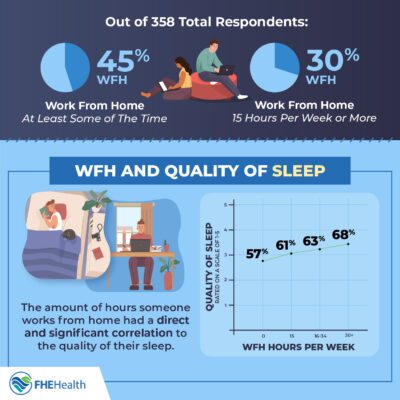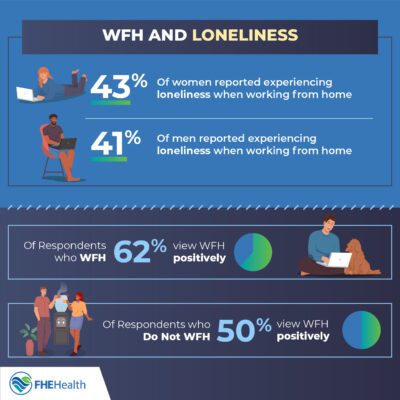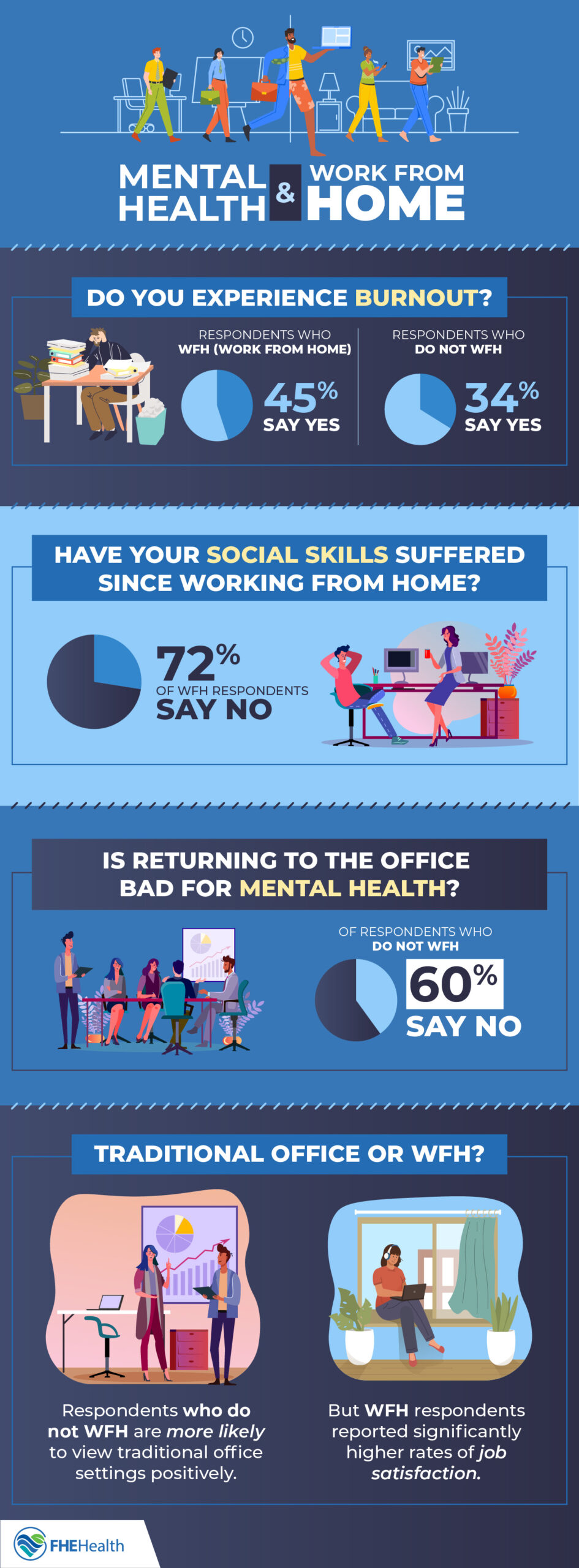
Technology has taken significant leaps in recent years, impacting how people work, including where they’re logging their hours from. According to WFH Research, a scholarly data collection project, about 0.4 percent of full paid workdays in the United States were worked from home in 1965. In the 1990s, this more than doubled to one percent, and then in the mid-2010s when more people had internet access from home, the number of people working from home leaped to four percent. Today, even more people regularly work from home –and navigate the perks and challenges that accompany remote work.
Introduction of Remote Work and Its Growing Post-COVID Popularity
Before COVID-19, the number of remote workers was already on the rise, roughly doubling every 15 years. Within just a few years’ time, workers had access to connectivity software such as Gmail and Slack, alongside video-conferencing platforms such as Webex and Zoom, reducing the need for face-to-face collaborations and in-office work.
In a 2022 press release, the U.S. Census Bureau reported that about nine million people, or 5.7 percent of workers, worked from home in 2019. In the weeks and months that followed, mandatory stay-at-home orders fast-tracked existing work-from-home trends, with workers clocking in from home about 60 percent of the time in 2020. In 2023, this number dropped to 25 percent of hours coming from remote work. While this is significantly lower than the number of remote hours during the peak of COVID, it still indicates a fivefold increase over 2019 norms.
Despite a push for workers to return to the office in 2023, working from home has remained popular, with many workers expressing a strong preference to clock in remotely at least a couple days per week. Workers cite a variety of reasons for their preference to work from home—greater flexibility, improved work-life balance and fewer work-related expenses.
The Goals of Our Survey
We wanted to delve into how working from home has impacted workers’ mental health. Have the perceived benefits of remote work translated into greater life satisfaction? Do workers truly enjoy the peace and solitude of working from home, or has it led to boredom and social isolation? How do they perceive their own mental health, and are they as likely to experience burnout as their in-office counterparts? Finally, does working from home really lead to better work-life balance?
Key Survey Findings
To learn about how remote work impacts mental health, we asked a series of questions to both work-from-home employees and those who work in traditional settings. These questions relate to sleep, socialization and stress, giving us insight into how working from home impacts mental health compared to clocking in from an office environment.
Those Who Work from Home Feel Positively about Remote Work
In general, those who work from home are more likely to see their job positively. When asked to rate their job’s impact on their mental health on a scale of 1-5, with “1” indicating negative feelings and “5” indicating positive, those who work from home provided an average rating of 3.1. On the other hand, those who work in traditional settings gave a neutral rating of 2.5.
Women were slightly more likely to report a link between good mental health and remote work, rating their experience at 3.22. By comparison, men reported a slightly lower, but still positive, score of 3.16.
Those Who Work from Home Have More Social Interactions
Does working from home lead to social isolation? Not according to about 80 percent of our survey respondents who work remotely. Altogether, about four out of five work-from-home employees reported a social satisfaction level of 3 or above on a 5-point scale. On average, those who work from home reported the quantity or quality of social interactions at 3.31. This held true for both men and women.
By comparison, those who work in traditional settings had an average answer of 3.00. Interestingly, women in this category reported higher average satisfaction levels with an overall average rating of 3.17. Men, on the other hand, expressed lower levels of satisfaction compared to women as well as their male work-from-home counterparts with an average score of 2.88.
We also asked participants how often they experienced loneliness or social isolation. The work-from-home group scored an average of 2.11 out of 5. While this indicates somewhat low levels of loneliness, it’s well above the average score of 1.03 reported by those who work in traditional office environments.
Women who work from home report the highest levels of loneliness at a score of 2.13. On the flip side, women who work outside the home have the lowest loneliness rating of 0.9. In contrast, men who work from home report a loneliness score of 2.08, while men who work outside the home had an average rating of 1.13.
Those Who Work from Home Report Better Sleep Quality

- For those who work 40+ hours, the average score was 3.42
- For those who work 16-34 hours from home, the average score was 3.17
- For those who work fewer than 15 hours per week from home, the average score was 3.09
On the other hand, the sleep quality score of non-work-from-home participants was below average at 2.88.
Those Who Work from Home Report Higher Job Satisfaction
Among all workers who participated in our survey, the average job satisfaction rating was 3.38 on a 5-point scale. However, those who work from home seemed to be happiest in their jobs, reporting an average of 3.85 points with 88 percent of these workers reporting a score of 3 or above. The overall job satisfaction rating among those who work in traditional settings is considerably lower at 3.01, with 65 percent of people answering with a 3 or higher.
The Mental Health Impact of Working from Home vs. Working in an Office
In our survey, we found that those who work from home enjoyed more and better-quality social interactions, higher job satisfaction and better sleep. However, we wanted to go deeper and determine whether this translated into better mental health. To gauge that, we asked questions related to how individuals perceive their mental health as well as their levels of stress and burnout.
Those Who Work from Home Report Slightly Better Mental Health

For more insight, we looked at participants’ gender. Overall, women reported a mental health score of 3.50. Women working from home reported a slightly lower score of 3.44 while women in the non-work-from-home crowd had a higher score of 3.87. Men who worked from home had the highest mental health score of 3.82, compared to 3.59 among their in-office counterparts and the overall score of 3.68.
Those Who Work from Home Report Slightly Higher Stress Scores
An individual’s stress levels play a vital role in their mental health, so we wanted to see whether those who work from home experience more or less stress than traditional workers. When we asked participants to rate their stress levels on a 5-points scale, with a lower score being more desirable, workers indicated an overall neutral score of 2.26. By comparison, the work-from-home group reported slightly more stress with a score of 2.60, while those who work in a traditional setting reported below-average levels of stress at a rating of 1.99.
Those Who Work from Home May Be More Likely to Experience Burnout
Does a person’s work environment make them more or less vulnerable to burnout? We asked our participants to rate their levels of burnout on a 0-5 scale, with 5 indicating constant. Overall, participants gave an average rating of 1.96 for this category. Surprisingly, those who work from home report an above-average burnout score of 2.27, while those in traditional work environments report a lower overall rating of 1.71.
Other Observations
When It Comes to Stress, Men Report Higher Levels than Women
From our survey results, it appears that a worker’s gender has some influence on the levels of stress they report. For example, on a 5-point scale, we find that women in traditional work environments report the lowest stress levels at an average score of 1.94, while men in traditional work environments are on their heels with an average rating of 2.06. By comparison, in the work-from-home group, women report a neutral score of 2.55 and men report a slightly higher rate of 2.67.
Those Who Work from Home May Have an Easier Time Disconnecting
Do those who work from home have a harder time disconnecting at the end of the day? Among those who answered this question, 66 percent said they had no trouble disconnecting while 34 percent reported difficulty. It appeared that those who work from home have a generally harder time transitioning out of their workday, with 38 percent of these workers reporting a difficult time disconnecting compared to 27 percent of those in traditional work environments.
Those Who Work from Home May Experience More Work-Related Physical Symptoms of Stress
When we asked workers whether they experience work-related physical symptoms of stress, such as headaches or muscle tension, 39 percent report that they do. This includes 48 percent of people who work from home compared to 31 percent of people who work in traditional settings.
Working from home provides greater flexibility, more time to invest in relationships and improved sleep. However, it’s not without its considerations, with remote workers often reporting more mental and physical symptoms of stress and burnout. Despite these challenges, the majority of remote workers report high job satisfaction and general wellness, showing the value work-from-home options provide workers.







